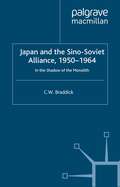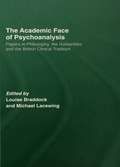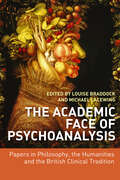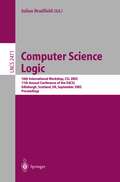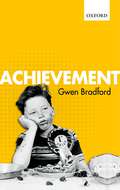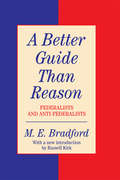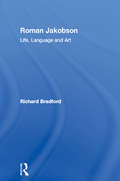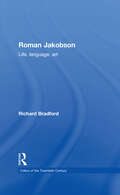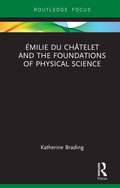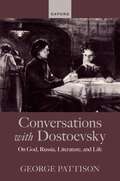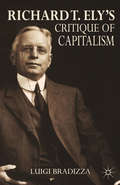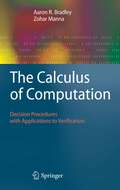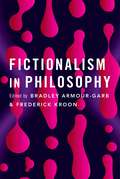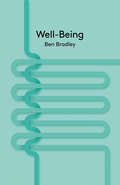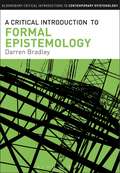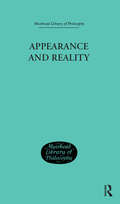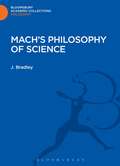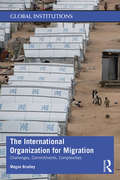- Table View
- List View
Japan and the Sino-Soviet Alliance, 1950-1964 (St Antony's Series)
by C. BraddickJapan and the Sino-Soviet Alliance 1950-1964 reveals the divisive impact of the Sino-Soviet Alliance on Japanese domestic politics and foreign relations during the turbulent years between 1950 and 1964. Drawing on extensive Japanese sources and unprecedented access to previously classified government documents, C.W. Braddick exposes the myths shrouding this formative era in Japan's postwar development.
The Academic Face of Psychoanalysis: Papers in Philosophy, the Humanities, and the British Clinical Tradition
by Louise Braddock Michael LacewingEver since Freud, psychoanalysts have explored the connections between psychoanalysis and literature and psychoanalysis and philosophy, while literary criticism, social science and philosophy have all reflected on and made use of ideas from psychoanalytic theory. The Academic Face of Psychoanalysis presents contributions from these fields and gives the reader an insight into different understandings and applications of psychoanalytic theory. This book comprises twelve contributions from experts in their fields covering philosophy, psychoanalysis, sociology and literary theory. The chapters are divided into three distinct sections: Psychoanalysis Philosophy Social science and literary theory Louise Braddock and Michael Lacewing successfully bring these contributions together with an in-depth introduction that allows the reader to explore the connections between the different disciplines. The multi-disciplinary approach to this book is rare; it will appeal to academics and students, from the subject areas of psychoanalysis, humanities and social science.
The Academic Face of Psychoanalysis: Papers in Philosophy, the Humanities, and the British Clinical Tradition
by Louise Braddock Michael LacewingEver since Freud, psychoanalysts have explored the connections between psychoanalysis and literature and psychoanalysis and philosophy, while literary criticism, social science and philosophy have all reflected on and made use of ideas from psychoanalytic theory. The Academic Face of Psychoanalysis presents contributions from these fields and gives the reader an insight into different understandings and applications of psychoanalytic theory. This book comprises twelve contributions from experts in their fields covering philosophy, psychoanalysis, sociology and literary theory. The chapters are divided into three distinct sections: Psychoanalysis Philosophy Social science and literary theory Louise Braddock and Michael Lacewing successfully bring these contributions together with an in-depth introduction that allows the reader to explore the connections between the different disciplines. The multi-disciplinary approach to this book is rare; it will appeal to academics and students, from the subject areas of psychoanalysis, humanities and social science.
Computer Science Logic: 16th International Workshop, CSL 2002, 11th Annual Conference of the EACSL, Edinburgh, Scotland, UK, September (Lecture Notes in Computer Science #2471)
by Julian BradfieldThe Annual Conference of the European Association for Computer Science Logic, CSL 2002, was held in the Old College of the University of Edinburgh on 22–25 September 2002. The conference series started as a programme of Int- national Workshops on Computer Science Logic, and then in its sixth meeting became the Annual Conference of the EACSL. This conference was the sixteenth meeting and eleventh EACSL conference; it was organized by the Laboratory for Foundations of Computer Science at the University of Edinburgh. The CSL 2002 Programme Committee considered 111 submissions from 28 countries during a two week electronic discussion; each paper was refereed by at least three reviewers. The Committee selected 37 papers for presentation at the conference and publication in these proceedings. The Programme Committee invited lectures from Susumu Hayashi, Frank Neven, and Damian Niwinski; ´ the papers provided by the invited speakers appear at the front of this volume. In addition to the main conference, two tutorials – ‘Introduction to Mu- Calculi’ (Julian Brad?eld) and ‘Parametrized Complexity’ (Martin Grohe) – were given on the previous day.
Achievement
by Gwen BradfordFrom the magisterial to the mundane, achievements play a role in the best kind of human life, and many people think that they are of such importance that they are worth pursuing at the expense of serious sacrifices. Yet for all that, no philosophers have devoted more than a few short passages to discerning what makes achievements valuable, or even what makes something an achievement to begin with. Gwen Bradford presents the first systematic account of what achievements are, and what it is about them that makes them worth doing. It turns out that more things count as achievements than we might have thought, and that what makes them valuable isn't something we usually think of as good. It turns out that difficulty, perhaps surprisingly, plays a central part in characterizing achievements and their value: achievements are worth the effort. But just what does it mean for something to be difficult, and why is it valuable? A thorough analysis of the nature of difficulty is given, and ultimately, the best account of the value of achievements taps into perfectionist axiology. But not just any perfectionist theory of value will do, and in this book we see a new perfectionist theory developed that succeeds in capturing the value of achievement better than its predecessors.
Achievement
by Gwen BradfordFrom the magisterial to the mundane, achievements play a role in the best kind of human life, and many people think that they are of such importance that they are worth pursuing at the expense of serious sacrifices. Yet for all that, no philosophers have devoted more than a few short passages to discerning what makes achievements valuable, or even what makes something an achievement to begin with. Gwen Bradford presents the first systematic account of what achievements are, and what it is about them that makes them worth doing. It turns out that more things count as achievements than we might have thought, and that what makes them valuable isn't something we usually think of as good. It turns out that difficulty, perhaps surprisingly, plays a central part in characterizing achievements and their value: achievements are worth the effort. But just what does it mean for something to be difficult, and why is it valuable? A thorough analysis of the nature of difficulty is given, and ultimately, the best account of the value of achievements taps into perfectionist axiology. But not just any perfectionist theory of value will do, and in this book we see a new perfectionist theory developed that succeeds in capturing the value of achievement better than its predecessors.
A Better Guide Than Reason: Federalists and Anti-federalists (The Library of Conservative Thought)
by M.E. BradfordIn this seminal volume, M. E. Bradford defines the Old Whig political tradition in American thought, showing that the inheritance of the prescriptive anti-federalists still lives. For Bradford, important elements in our heritage from the American Revolution have been systematically hidden from our view by anachronistic and partisan scholarship. He believes that other, more ideological components have been emphasized at the expense of the rest. Here he attempts to return us to our heritage.
A Better Guide Than Reason: Federalists and Anti-federalists (The Library of Conservative Thought)
by M.E. BradfordIn this seminal volume, M. E. Bradford defines the Old Whig political tradition in American thought, showing that the inheritance of the prescriptive anti-federalists still lives. For Bradford, important elements in our heritage from the American Revolution have been systematically hidden from our view by anachronistic and partisan scholarship. He believes that other, more ideological components have been emphasized at the expense of the rest. Here he attempts to return us to our heritage.
Roman Jakobson: Life, Language and Art (Critics of the Twentieth Century)
by Richard BradfordIn Roman Jakobson Richard Bradford reasserts the value of Jakobson's work, arguing that he has a great deal to offer contemporary critical theory and providing a critical appraisal the sweep of Jakobson's career. Bradford re-establishes Jakobson's work as vital to our understanding of the relationship between language and poetry. By exploring Jakobson's thesis that poetry is the primary object language, Roman Jakobson: Life, Language, Art offers a new reading of his work which includes the most radical elements of modernism. This book will be invaluable to students of Jakobson and to anyone interested in the development of critical theory, linguistics and stylistics.
Roman Jakobson: Life, Language and Art (Critics of the Twentieth Century)
by Richard BradfordIn Roman Jakobson Richard Bradford reasserts the value of Jakobson's work, arguing that he has a great deal to offer contemporary critical theory and providing a critical appraisal the sweep of Jakobson's career. Bradford re-establishes Jakobson's work as vital to our understanding of the relationship between language and poetry. By exploring Jakobson's thesis that poetry is the primary object language, Roman Jakobson: Life, Language, Art offers a new reading of his work which includes the most radical elements of modernism. This book will be invaluable to students of Jakobson and to anyone interested in the development of critical theory, linguistics and stylistics.
Émilie Du Châtelet and the Foundations of Physical Science (Routledge Focus on Philosophy)
by Katherine BradingThe centerpiece of Émilie Du Châtelet’s philosophy of science is her Foundations of Physics, first published in 1740. The Foundations contains epistemology, metaphysics, methodology, mechanics, and physics, including such pressing issues of the time as whether there are atoms, the appropriate roles of God and of hypotheses in scientific theorizing, how (if at all) bodies are capable of acting on one another, and whether gravity is an action-at-a-distance force. Du Châtelet sought to resolve these issues within a single philosophical framework that builds on her critique and appraisal of all the leading alternatives (Cartesian, Newtonian, Leibnizian, and so forth) of the period. The text is remarkable for being the first to attempt such a synthetic project, and even more so for the accessibility and clarity of the writing. This book argues that Du Châtelet put her finger on the central problems that lay at the intersection of physics and metaphysics at the time, and tackled them drawing on the most up-to-date resources available. It will be a useful source for students and scholars interested in the history and philosophy of science, and in the impact of women philosophers in the early modern period.
Émilie Du Châtelet and the Foundations of Physical Science (Routledge Focus on Philosophy)
by Katherine BradingThe centerpiece of Émilie Du Châtelet’s philosophy of science is her Foundations of Physics, first published in 1740. The Foundations contains epistemology, metaphysics, methodology, mechanics, and physics, including such pressing issues of the time as whether there are atoms, the appropriate roles of God and of hypotheses in scientific theorizing, how (if at all) bodies are capable of acting on one another, and whether gravity is an action-at-a-distance force. Du Châtelet sought to resolve these issues within a single philosophical framework that builds on her critique and appraisal of all the leading alternatives (Cartesian, Newtonian, Leibnizian, and so forth) of the period. The text is remarkable for being the first to attempt such a synthetic project, and even more so for the accessibility and clarity of the writing. This book argues that Du Châtelet put her finger on the central problems that lay at the intersection of physics and metaphysics at the time, and tackled them drawing on the most up-to-date resources available. It will be a useful source for students and scholars interested in the history and philosophy of science, and in the impact of women philosophers in the early modern period.
Philosophical Mechanics in the Age of Reason
by Katherine Brading Marius StanFrom pebbles to planets, tigers to tables, pine trees to people; animate and inanimate, natural and artificial; bodies are everywhere. Bodies populate the world, acting and interacting with one another, and they are the subject-matter of Newton's laws of motion. But what is a body? And how can we know how they behave? In Philosophical Mechanics in the Age of Reason, Katherine Brading and Marius Stan examine the struggle for a theory of bodies. At the beginning of the 18th century, physics was the branch of philosophy that studied bodies in general. Its primary task was to provide a qualitative account of the nature of bodies, including their essential properties, causal powers, and generic behaviors. Pursued by a variety of figures both canonical (from Leibniz to Kant) and less familiar (from Du Ch?telet and Euler to d'Alembert and Lagrange), this proved a difficult task. At stake were the appropriate epistemologies and methods for theorizing about the natural world. Solutions demanded the combined resources of philosophy, physics, and mechanics: what Brading and Stan call a ?philosophical mechanics.? Brading and Stan analyze a century of widespread, concerted efforts to solve ?the problem of bodies,? they examine the consequences of the many failures, both for the problem itself and for philosophy more generally. They reveal relationships among disparate themes of 18th century physics and philosophy, from the nature of matter to the motion of a vibrating string; causation to the principle of least action; and the role of subtle matter in collision theory to analytic mechanics. All of these, Brading and Stan argue, are related to the eventual emergence of physics as an independent discipline, autonomous from philosophy, more than a century after Newton's Principia. This book provides a new framing of natural philosophy and its transformations in the Enlightenment; and it proposes an account of how physics and philosophy evolved into distinct fields of inquiry.
Philosophical Mechanics in the Age of Reason
by Katherine Brading Marius StanFrom pebbles to planets, tigers to tables, pine trees to people; animate and inanimate, natural and artificial; bodies are everywhere. Bodies populate the world, acting and interacting with one another, and they are the subject-matter of Newton's laws of motion. But what is a body? And how can we know how they behave? In Philosophical Mechanics in the Age of Reason, Katherine Brading and Marius Stan examine the struggle for a theory of bodies. At the beginning of the 18th century, physics was the branch of philosophy that studied bodies in general. Its primary task was to provide a qualitative account of the nature of bodies, including their essential properties, causal powers, and generic behaviors. Pursued by a variety of figures both canonical (from Leibniz to Kant) and less familiar (from Du Ch?telet and Euler to d'Alembert and Lagrange), this proved a difficult task. At stake were the appropriate epistemologies and methods for theorizing about the natural world. Solutions demanded the combined resources of philosophy, physics, and mechanics: what Brading and Stan call a ?philosophical mechanics.? Brading and Stan analyze a century of widespread, concerted efforts to solve ?the problem of bodies,? they examine the consequences of the many failures, both for the problem itself and for philosophy more generally. They reveal relationships among disparate themes of 18th century physics and philosophy, from the nature of matter to the motion of a vibrating string; causation to the principle of least action; and the role of subtle matter in collision theory to analytic mechanics. All of these, Brading and Stan argue, are related to the eventual emergence of physics as an independent discipline, autonomous from philosophy, more than a century after Newton's Principia. This book provides a new framing of natural philosophy and its transformations in the Enlightenment; and it proposes an account of how physics and philosophy evolved into distinct fields of inquiry.
Richard T. Ely’s Critique of Capitalism
by L. BradizzaThis book examines the work and thought of Richard T. Ely in light of his rejection of capitalism and view toward individualism. It concludes that there are real problems with Ely's theories and the principles of Progressivism, and addresses the implications of this for current American political thought.
The Calculus of Computation: Decision Procedures with Applications to Verification
by Aaron R. Bradley Zohar MannaWritten with graduate and advanced undergraduate students in mind, this textbook introduces computational logic from the foundations of first-order logic to state-of-the-art decision procedures for arithmetic, data structures, and combination theories. The textbook also presents a logical approach to engineering correct software. Verification exercises are given to develop the reader's facility in specifying and verifying software using logic. The treatment of verification concludes with an introduction to the static analysis of software, an important component of modern verification systems. The final chapter outlines courses of further study.
Fictionalism in Philosophy
by Bradley Armour-Garb and Frederick KroonThere are things we routinely say that may strike us as literally false but that we are nonetheless reluctant to give up. This might be something mundane, like the way we talk about the sun setting in the west (it is the earth that moves), or it could be something much deeper, like engaging in talk that is ostensibly about numbers despite believing that numbers do not literally exist. Rather than regard such behaviour as self-defeating, a "fictionalist" is someone who thinks that this kind of discourse is entirely appropriate, even helpful, so long as we treat what is said as a useful fiction, rather than as the sober truth. "Fictionalism" can be broadly understood as a view that uses a notion of pretense or fiction in order to resolve certain puzzles or problems that otherwise do not necessarily have anything to do with literature or fictional creations. Within contemporary analytic philosophy, fictionalism has been on the scene for well over a decade and has matured during that time, growing in popularity. There are now myriad competing views about fictionalism and consequently the discussion has branched out into many more subdisciplines of philosophy. Yet there is widespread disagreement on what philosophical fictionalism actually amounts to and about how precisely it ought to be pursued. This volume aims to guide these discussions, collecting some of the most up-to-date work on fictionalism and tracing the view's development over the past decade. After a detailed discussion in the book's introductory chapter of how philosophers should think of fictionalism and its connection to metaontology more generally, the remaining chapters provide readers with arguments for and against this view from leading scholars in the fields of epistemology, ethics, metaphysics, philosophy of science, philosophy of language, and others.
Well-Being (Key Concepts in Philosophy)
by Ben BradleyThe concept of well-being plays a central role in moral and political theory. Policies and actions are justified or criticized on the grounds that they make people better or worse off. But is there really such a thing as well-being, and if so, what is it? Is it pleasure, desire-satisfaction, knowledge, virtue, achievement, some combination of these, or something else entirely? How can we measure well-being, amongst individuals and society? And how can we use it to make moral judgements about people, policies and institutions? In this entertaining and accessible new book, Ben Bradley guides readers through the various philosophical theories of well-being, such as hedonism, perfectionism and pluralism, showing the benefits and drawbacks of each theory. He explores the role of well-being in moral and political theory, and the limitations of welfare-based approaches to ethics such as utilitarianism and welfare egalitarianism. Finally, he introduces puzzles about well-being that arise in moral and prudential deliberations about procreation and death. Well-Being is an ideal introduction to these topics for those with no philosophical background, or for philosophers looking for an overview of current thinking about the subject.
A Critical Introduction to Formal Epistemology (Bloomsbury Critical Introductions to Contemporary Epistemology)
by Darren BradleyFormal methods are changing how epistemology is being studied and understood. A Critical Introduction to Formal Epistemology introduces the types of formal theories being used and explains how they are shaping the subject.Beginning with the basics of probability and Bayesianism, it shows how representing degrees of belief using probabilities informs central debates in epistemology. As well as discussing induction, the paradox of confirmation and the main challenges to Bayesianism, this comprehensive overview covers objective chance, peer disagreement, the concept of full belief, and the traditional problems of justification and knowledge. Subjecting each position to a critical analysis, it explains the main issues in formal epistemology, and the motivations and drawbacks of each position. Written in an accessible language and supported study questions, guides to further reading and a glossary, positions are placed in an historic context to give a sense of the development of the field. As the first introductory textbook on formal epistemology, A Critical Introduction to Formal Epistemology is an invaluable resource for students and scholars of contemporary epistemology.
A Critical Introduction to Formal Epistemology (Bloomsbury Critical Introductions to Contemporary Epistemology)
by Darren BradleyFormal methods are changing how epistemology is being studied and understood. A Critical Introduction to Formal Epistemology introduces the types of formal theories being used and explains how they are shaping the subject.Beginning with the basics of probability and Bayesianism, it shows how representing degrees of belief using probabilities informs central debates in epistemology. As well as discussing induction, the paradox of confirmation and the main challenges to Bayesianism, this comprehensive overview covers objective chance, peer disagreement, the concept of full belief, and the traditional problems of justification and knowledge. Subjecting each position to a critical analysis, it explains the main issues in formal epistemology, and the motivations and drawbacks of each position. Written in an accessible language and supported study questions, guides to further reading and a glossary, positions are placed in an historic context to give a sense of the development of the field. As the first introductory textbook on formal epistemology, A Critical Introduction to Formal Epistemology is an invaluable resource for students and scholars of contemporary epistemology.
Appearance and Reality: A Metaphysical Essay
by Bradley, F HFirst published in 2002. This is the revised second edition of a volume of an essay on metaphysics, originally published in 1897.
Appearance and Reality: A Metaphysical Essay
by Bradley, F HFirst published in 2002. This is the revised second edition of a volume of an essay on metaphysics, originally published in 1897.
Mach's Philosophy of Science (Bloomsbury Academic Collections: Philosophy)
by J. BradleyDr Bradley's aim is to provide a work which will introduce readers to the philosophical standpoint employed by Mach in his expositions of physics. The author shows how Mach traces out the evolution of the metrical concepts of heat and mechanics, and includes a discussion of his reformulation of Newton's dynamical principles. Mach's view that we have a semi-awareness of both time and temperature is considered: there is no 'Mach Principle' in Mach's writings; the use of the term by Einstein and others has led to confusion, which the author attempts to remove. The newcomer to the philosophy of science is led to an insight into the methods of one who has had a major influence on the subject.
The International Organization for Migration: Challenges, Commitments, Complexities (Global Institutions)
by Megan BradleySince its establishment in 1951, the International Organization for Migration (IOM) has expanded from a small, regionally specific, logistically focused outfit into a major international organization involved in an almost dizzying array of activities related to human mobility. In 2016, IOM joined the UN system and has rebranded itself as the "UN migration agency." Despite its dramatic expansion and increasing influence, IOM remains understudied. This book provides an accessible, incisive introduction to IOM, focusing on its humanitarian activities and responses to forced migration – work that now makes up the majority of the organization’s budget, staff, and field presence. IOM’s humanitarian work is often overlooked or dismissed as a veil for its involvement in other activities that serve states’ interests in restricting migration. In contrast, Bradley argues that understanding IOM’s involvement in humanitarian action and work with displaced persons is pivotal to comprehending its evolution and contemporary significance. Examining tensions and controversies surrounding the agency’s activities, including in the complex cases of Haiti and Libya, the book considers how IOM’s structure, culture, and internal and external power struggles have shaped its behaviour. It demonstrates how IOM has grown by acting as an entrepreneur, cultivating autonomy and influence well beyond its limited formal mandate. The International Organization for Migration is essential reading for students and scholars of migration, humanitarianism, and international organizations.
The International Organization for Migration: Challenges, Commitments, Complexities (Global Institutions)
by Megan BradleySince its establishment in 1951, the International Organization for Migration (IOM) has expanded from a small, regionally specific, logistically focused outfit into a major international organization involved in an almost dizzying array of activities related to human mobility. In 2016, IOM joined the UN system and has rebranded itself as the "UN migration agency." Despite its dramatic expansion and increasing influence, IOM remains understudied. This book provides an accessible, incisive introduction to IOM, focusing on its humanitarian activities and responses to forced migration – work that now makes up the majority of the organization’s budget, staff, and field presence. IOM’s humanitarian work is often overlooked or dismissed as a veil for its involvement in other activities that serve states’ interests in restricting migration. In contrast, Bradley argues that understanding IOM’s involvement in humanitarian action and work with displaced persons is pivotal to comprehending its evolution and contemporary significance. Examining tensions and controversies surrounding the agency’s activities, including in the complex cases of Haiti and Libya, the book considers how IOM’s structure, culture, and internal and external power struggles have shaped its behaviour. It demonstrates how IOM has grown by acting as an entrepreneur, cultivating autonomy and influence well beyond its limited formal mandate. The International Organization for Migration is essential reading for students and scholars of migration, humanitarianism, and international organizations.
